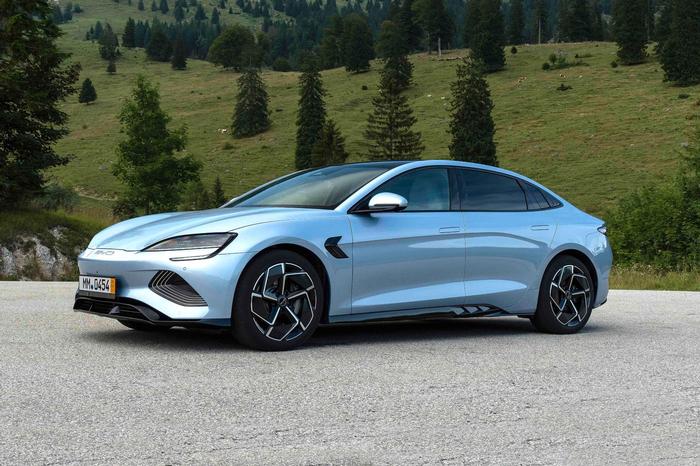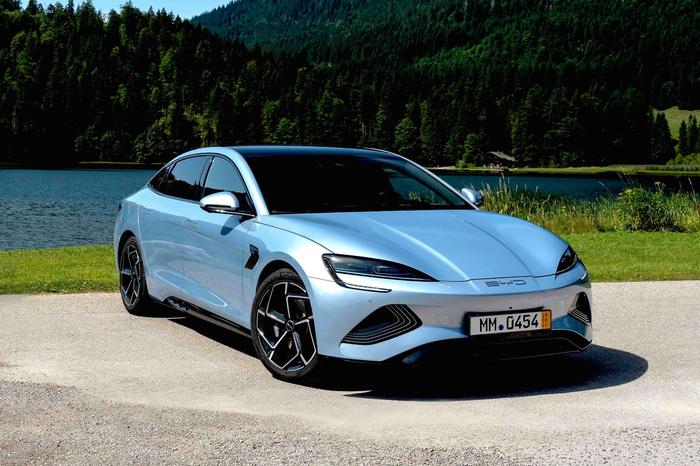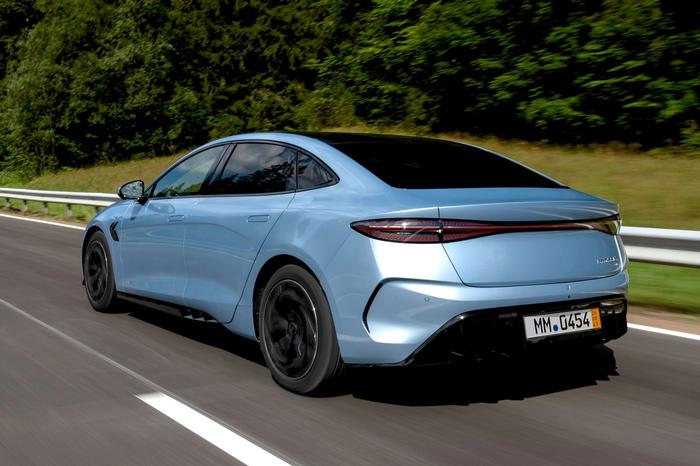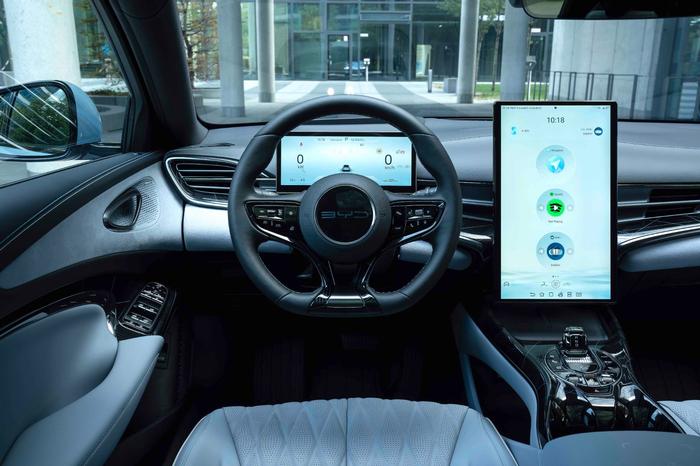2023 BYD Seal Saloon Review

The BYD Seal is an electric saloon with plenty of performance and premium aspirations.
The BYD Seal is an electric saloon with plenty of performance and premium aspirations.
Review
Pros: good interior, great performance, refined driving experience
Cons: driver assistance systems could be better
BYD Seal Design
The BYD Seal is a four-door saloon that is a close match to the Tesla Model 3, Hyundai Ioniq 6 and, when it arrives, the Volkswagen ID.7. As with its electric rivals, the Seal has a sleek design to boost its efficiency and runs on 19-inch alloy wheels as standard. Easily recognisable by its wave-inspired LED daytime running lights that form a pattern in the lower corners of the front bumper, the Seal has a low bonnet that can open to access a 53-litre storage area that’s ideal for storing charging cables.
In what is becoming an increasingly common feature, the door handles retract to sit flush against the bodywork when the car is locked and pop out to meet you when getting into the car. A crease running from the front wing to the rear wheel adds some detail to the side while there’s a wrap-around rear light bar that includes dozens of tiny, illuminated dots inspired by water droplets.
BYD Seal Interior
There is a pleasing blend of materials inside the Seal, with the choice of black upholstery or a more distinctive Tahiti Blue, contrasting with the darker elements of the interior. The overall look is more mature than that of the BYD Atto 3 — you won’t find any guitar strings in the doors of the Seal, for example. Electrically adjustable front seats and a manually adjustable steering wheel (for reach and rake) make finding a comfortable driving position easy. The sports seats have good side support and are comfortable over long journeys, too.
Ahead of the flat-bottomed leather multifunction steering wheel is a 10.25-inch digital instrument panel and, on higher-spec Excellence versions, a head-up display too. As with the Atto 3, the Seal uses a rotatable touchscreen for the infotainment system. At 15.6 inches across the diagonal, this screen dominates the cabin and quickly reacts to inputs. The infotainment system itself is full of features but easy to navigate. Other than volume controls and drive modes, everything else is within the system, including temperature settings.
Underneath the display are two wireless charging pads. Below that is another storage area containing USB charging ports. You do need a wired connection for using Apple CarPlay, though, so it’s annoying that these USB ports are awkward to access. Rear passenger space is generous, with plenty of legroom and headroom, the latter helped by a large panoramic glass roof that is standard. The boot isn’t huge at 400 litres, and the aperture isn’t as large as what you’d get in a hatchback, but if you need to load larger items, the rear seats can split and fold forward.
BYD Seal Performance & Drive
The model line-up for the Seal is a simple one that consists of two versions, both using an 82.5kWh battery. That can use an 11kW AC charger and can DC rapid charge at up to 150kW, which means that recharging from 10 per cent to 80 per cent takes 37 minutes in theory.
The Seal Design uses a single-motor, rear-wheel-drive setup with a maximum output of 312hp and a WLTP driving range of 570 kilometres. Performance is brisk, with the 0-100km/h dash taking only 5.9 seconds. Given its range and lower price, this version will likely be the more popular choice. In the dual-motor Seal Excellence, the range decreases to 520 kilometres, but performance increases with outputs of 530hp and 670Nm. That means accelerating from 0-100km/h takes only 3.8 seconds.
Despite having such strong performance figures, the Seal drives with a high degree of civility. You only get an impression of its sports-car-like acceleration and performance if you switch to the Sport mode and go looking for it. When you do, the Seal’s performance is nothing short of impressive and, even when already travelling at motorway cruising speeds, it will surge forward at a serious rate.
However, what makes even more of an impression is just how refined the Seal is. Being electric obviously helps and removes engine noise and vibration. Added to that are acoustically optimised front side windows that help to reduce cabin noise further. There are numerous driver assistance systems as standard. However, we found some of them overly sensitive to the point where we wanted to deactivate them. The steering has a nice feel and is relatively communicative, though. The suspension provides a smooth and comfortable ride while maintaining a high degree of composure.
BYD Seal Pricing
Prices for the BYD Seal in Ireland will start from €40,567 for the COMFORT model, arriving in 2024, based on current subsidies.The first model to arrive in Ireland will be the DESIGN model, expected to be the most popular choice, and the EXCELLENCE model, both due here in Q4 2023 and starting from €44,036 and €49,836 respectively.
Carzone Verdict
Even though the BYD name is still building up recognition in Ireland, the cars it produces have impressed, and the Seal continues that. The standard equipment is excellent, and the overall design is an attractive one. Perhaps more important to some is the outright performance and driving range, thanks to a large battery. Aside from some minor niggles with the driver assistance systems, the BYD Seal is an excellent package making it one of the more compelling EVs on sale.
2023 BYD Seal Saloon Review

The BYD Seal is an electric saloon with plenty of performance and premium aspirations.
The BYD Seal is an electric saloon with plenty of performance and premium aspirations.
Review
Pros: good interior, great performance, refined driving experience
Cons: driver assistance systems could be better
BYD Seal Design
The BYD Seal is a four-door saloon that is a close match to the Tesla Model 3, Hyundai Ioniq 6 and, when it arrives, the Volkswagen ID.7. As with its electric rivals, the Seal has a sleek design to boost its efficiency and runs on 19-inch alloy wheels as standard. Easily recognisable by its wave-inspired LED daytime running lights that form a pattern in the lower corners of the front bumper, the Seal has a low bonnet that can open to access a 53-litre storage area that’s ideal for storing charging cables.
In what is becoming an increasingly common feature, the door handles retract to sit flush against the bodywork when the car is locked and pop out to meet you when getting into the car. A crease running from the front wing to the rear wheel adds some detail to the side while there’s a wrap-around rear light bar that includes dozens of tiny, illuminated dots inspired by water droplets.
BYD Seal Interior
There is a pleasing blend of materials inside the Seal, with the choice of black upholstery or a more distinctive Tahiti Blue, contrasting with the darker elements of the interior. The overall look is more mature than that of the BYD Atto 3 — you won’t find any guitar strings in the doors of the Seal, for example. Electrically adjustable front seats and a manually adjustable steering wheel (for reach and rake) make finding a comfortable driving position easy. The sports seats have good side support and are comfortable over long journeys, too.
Ahead of the flat-bottomed leather multifunction steering wheel is a 10.25-inch digital instrument panel and, on higher-spec Excellence versions, a head-up display too. As with the Atto 3, the Seal uses a rotatable touchscreen for the infotainment system. At 15.6 inches across the diagonal, this screen dominates the cabin and quickly reacts to inputs. The infotainment system itself is full of features but easy to navigate. Other than volume controls and drive modes, everything else is within the system, including temperature settings.
Underneath the display are two wireless charging pads. Below that is another storage area containing USB charging ports. You do need a wired connection for using Apple CarPlay, though, so it’s annoying that these USB ports are awkward to access. Rear passenger space is generous, with plenty of legroom and headroom, the latter helped by a large panoramic glass roof that is standard. The boot isn’t huge at 400 litres, and the aperture isn’t as large as what you’d get in a hatchback, but if you need to load larger items, the rear seats can split and fold forward.
BYD Seal Performance & Drive
The model line-up for the Seal is a simple one that consists of two versions, both using an 82.5kWh battery. That can use an 11kW AC charger and can DC rapid charge at up to 150kW, which means that recharging from 10 per cent to 80 per cent takes 37 minutes in theory.
The Seal Design uses a single-motor, rear-wheel-drive setup with a maximum output of 312hp and a WLTP driving range of 570 kilometres. Performance is brisk, with the 0-100km/h dash taking only 5.9 seconds. Given its range and lower price, this version will likely be the more popular choice. In the dual-motor Seal Excellence, the range decreases to 520 kilometres, but performance increases with outputs of 530hp and 670Nm. That means accelerating from 0-100km/h takes only 3.8 seconds.
Despite having such strong performance figures, the Seal drives with a high degree of civility. You only get an impression of its sports-car-like acceleration and performance if you switch to the Sport mode and go looking for it. When you do, the Seal’s performance is nothing short of impressive and, even when already travelling at motorway cruising speeds, it will surge forward at a serious rate.
However, what makes even more of an impression is just how refined the Seal is. Being electric obviously helps and removes engine noise and vibration. Added to that are acoustically optimised front side windows that help to reduce cabin noise further. There are numerous driver assistance systems as standard. However, we found some of them overly sensitive to the point where we wanted to deactivate them. The steering has a nice feel and is relatively communicative, though. The suspension provides a smooth and comfortable ride while maintaining a high degree of composure.
BYD Seal Pricing
Prices for the BYD Seal in Ireland will start from €40,567 for the COMFORT model, arriving in 2024, based on current subsidies.The first model to arrive in Ireland will be the DESIGN model, expected to be the most popular choice, and the EXCELLENCE model, both due here in Q4 2023 and starting from €44,036 and €49,836 respectively.
Carzone Verdict
Even though the BYD name is still building up recognition in Ireland, the cars it produces have impressed, and the Seal continues that. The standard equipment is excellent, and the overall design is an attractive one. Perhaps more important to some is the outright performance and driving range, thanks to a large battery. Aside from some minor niggles with the driver assistance systems, the BYD Seal is an excellent package making it one of the more compelling EVs on sale.
2023 BYD Seal Saloon Review

The BYD Seal is an electric saloon with plenty of performance and premium aspirations.
The BYD Seal is an electric saloon with plenty of performance and premium aspirations.
Review
Pros: good interior, great performance, refined driving experience
Cons: driver assistance systems could be better
BYD Seal Design
The BYD Seal is a four-door saloon that is a close match to the Tesla Model 3, Hyundai Ioniq 6 and, when it arrives, the Volkswagen ID.7. As with its electric rivals, the Seal has a sleek design to boost its efficiency and runs on 19-inch alloy wheels as standard. Easily recognisable by its wave-inspired LED daytime running lights that form a pattern in the lower corners of the front bumper, the Seal has a low bonnet that can open to access a 53-litre storage area that’s ideal for storing charging cables.
In what is becoming an increasingly common feature, the door handles retract to sit flush against the bodywork when the car is locked and pop out to meet you when getting into the car. A crease running from the front wing to the rear wheel adds some detail to the side while there’s a wrap-around rear light bar that includes dozens of tiny, illuminated dots inspired by water droplets.
BYD Seal Interior
There is a pleasing blend of materials inside the Seal, with the choice of black upholstery or a more distinctive Tahiti Blue, contrasting with the darker elements of the interior. The overall look is more mature than that of the BYD Atto 3 — you won’t find any guitar strings in the doors of the Seal, for example. Electrically adjustable front seats and a manually adjustable steering wheel (for reach and rake) make finding a comfortable driving position easy. The sports seats have good side support and are comfortable over long journeys, too.
Ahead of the flat-bottomed leather multifunction steering wheel is a 10.25-inch digital instrument panel and, on higher-spec Excellence versions, a head-up display too. As with the Atto 3, the Seal uses a rotatable touchscreen for the infotainment system. At 15.6 inches across the diagonal, this screen dominates the cabin and quickly reacts to inputs. The infotainment system itself is full of features but easy to navigate. Other than volume controls and drive modes, everything else is within the system, including temperature settings.
Underneath the display are two wireless charging pads. Below that is another storage area containing USB charging ports. You do need a wired connection for using Apple CarPlay, though, so it’s annoying that these USB ports are awkward to access. Rear passenger space is generous, with plenty of legroom and headroom, the latter helped by a large panoramic glass roof that is standard. The boot isn’t huge at 400 litres, and the aperture isn’t as large as what you’d get in a hatchback, but if you need to load larger items, the rear seats can split and fold forward.
BYD Seal Performance & Drive
The model line-up for the Seal is a simple one that consists of two versions, both using an 82.5kWh battery. That can use an 11kW AC charger and can DC rapid charge at up to 150kW, which means that recharging from 10 per cent to 80 per cent takes 37 minutes in theory.
The Seal Design uses a single-motor, rear-wheel-drive setup with a maximum output of 312hp and a WLTP driving range of 570 kilometres. Performance is brisk, with the 0-100km/h dash taking only 5.9 seconds. Given its range and lower price, this version will likely be the more popular choice. In the dual-motor Seal Excellence, the range decreases to 520 kilometres, but performance increases with outputs of 530hp and 670Nm. That means accelerating from 0-100km/h takes only 3.8 seconds.
Despite having such strong performance figures, the Seal drives with a high degree of civility. You only get an impression of its sports-car-like acceleration and performance if you switch to the Sport mode and go looking for it. When you do, the Seal’s performance is nothing short of impressive and, even when already travelling at motorway cruising speeds, it will surge forward at a serious rate.
However, what makes even more of an impression is just how refined the Seal is. Being electric obviously helps and removes engine noise and vibration. Added to that are acoustically optimised front side windows that help to reduce cabin noise further. There are numerous driver assistance systems as standard. However, we found some of them overly sensitive to the point where we wanted to deactivate them. The steering has a nice feel and is relatively communicative, though. The suspension provides a smooth and comfortable ride while maintaining a high degree of composure.
BYD Seal Pricing
Prices for the BYD Seal in Ireland will start from €40,567 for the COMFORT model, arriving in 2024, based on current subsidies.The first model to arrive in Ireland will be the DESIGN model, expected to be the most popular choice, and the EXCELLENCE model, both due here in Q4 2023 and starting from €44,036 and €49,836 respectively.
Carzone Verdict
Even though the BYD name is still building up recognition in Ireland, the cars it produces have impressed, and the Seal continues that. The standard equipment is excellent, and the overall design is an attractive one. Perhaps more important to some is the outright performance and driving range, thanks to a large battery. Aside from some minor niggles with the driver assistance systems, the BYD Seal is an excellent package making it one of the more compelling EVs on sale.
2023 BYD Seal Saloon Review

The BYD Seal is an electric saloon with plenty of performance and premium aspirations.
The BYD Seal is an electric saloon with plenty of performance and premium aspirations.
Review
Pros: good interior, great performance, refined driving experience
Cons: driver assistance systems could be better
BYD Seal Design
The BYD Seal is a four-door saloon that is a close match to the Tesla Model 3, Hyundai Ioniq 6 and, when it arrives, the Volkswagen ID.7. As with its electric rivals, the Seal has a sleek design to boost its efficiency and runs on 19-inch alloy wheels as standard. Easily recognisable by its wave-inspired LED daytime running lights that form a pattern in the lower corners of the front bumper, the Seal has a low bonnet that can open to access a 53-litre storage area that’s ideal for storing charging cables.
In what is becoming an increasingly common feature, the door handles retract to sit flush against the bodywork when the car is locked and pop out to meet you when getting into the car. A crease running from the front wing to the rear wheel adds some detail to the side while there’s a wrap-around rear light bar that includes dozens of tiny, illuminated dots inspired by water droplets.
BYD Seal Interior
There is a pleasing blend of materials inside the Seal, with the choice of black upholstery or a more distinctive Tahiti Blue, contrasting with the darker elements of the interior. The overall look is more mature than that of the BYD Atto 3 — you won’t find any guitar strings in the doors of the Seal, for example. Electrically adjustable front seats and a manually adjustable steering wheel (for reach and rake) make finding a comfortable driving position easy. The sports seats have good side support and are comfortable over long journeys, too.
Ahead of the flat-bottomed leather multifunction steering wheel is a 10.25-inch digital instrument panel and, on higher-spec Excellence versions, a head-up display too. As with the Atto 3, the Seal uses a rotatable touchscreen for the infotainment system. At 15.6 inches across the diagonal, this screen dominates the cabin and quickly reacts to inputs. The infotainment system itself is full of features but easy to navigate. Other than volume controls and drive modes, everything else is within the system, including temperature settings.
Underneath the display are two wireless charging pads. Below that is another storage area containing USB charging ports. You do need a wired connection for using Apple CarPlay, though, so it’s annoying that these USB ports are awkward to access. Rear passenger space is generous, with plenty of legroom and headroom, the latter helped by a large panoramic glass roof that is standard. The boot isn’t huge at 400 litres, and the aperture isn’t as large as what you’d get in a hatchback, but if you need to load larger items, the rear seats can split and fold forward.
BYD Seal Performance & Drive
The model line-up for the Seal is a simple one that consists of two versions, both using an 82.5kWh battery. That can use an 11kW AC charger and can DC rapid charge at up to 150kW, which means that recharging from 10 per cent to 80 per cent takes 37 minutes in theory.
The Seal Design uses a single-motor, rear-wheel-drive setup with a maximum output of 312hp and a WLTP driving range of 570 kilometres. Performance is brisk, with the 0-100km/h dash taking only 5.9 seconds. Given its range and lower price, this version will likely be the more popular choice. In the dual-motor Seal Excellence, the range decreases to 520 kilometres, but performance increases with outputs of 530hp and 670Nm. That means accelerating from 0-100km/h takes only 3.8 seconds.
Despite having such strong performance figures, the Seal drives with a high degree of civility. You only get an impression of its sports-car-like acceleration and performance if you switch to the Sport mode and go looking for it. When you do, the Seal’s performance is nothing short of impressive and, even when already travelling at motorway cruising speeds, it will surge forward at a serious rate.
However, what makes even more of an impression is just how refined the Seal is. Being electric obviously helps and removes engine noise and vibration. Added to that are acoustically optimised front side windows that help to reduce cabin noise further. There are numerous driver assistance systems as standard. However, we found some of them overly sensitive to the point where we wanted to deactivate them. The steering has a nice feel and is relatively communicative, though. The suspension provides a smooth and comfortable ride while maintaining a high degree of composure.
BYD Seal Pricing
Prices for the BYD Seal in Ireland will start from €40,567 for the COMFORT model, arriving in 2024, based on current subsidies.The first model to arrive in Ireland will be the DESIGN model, expected to be the most popular choice, and the EXCELLENCE model, both due here in Q4 2023 and starting from €44,036 and €49,836 respectively.
Carzone Verdict
Even though the BYD name is still building up recognition in Ireland, the cars it produces have impressed, and the Seal continues that. The standard equipment is excellent, and the overall design is an attractive one. Perhaps more important to some is the outright performance and driving range, thanks to a large battery. Aside from some minor niggles with the driver assistance systems, the BYD Seal is an excellent package making it one of the more compelling EVs on sale.



